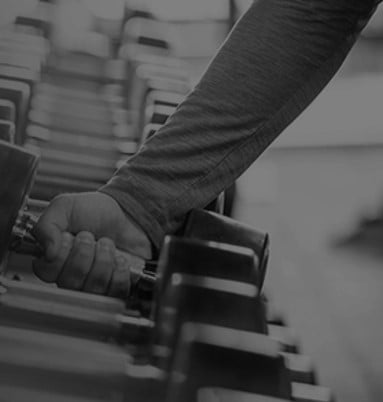
Subscribe to the Blog
Stay up to date
Regular weightlifting and exercising can be the basis of a fun, healthy lifestyle. However, doing it the right way is key. With proper exercise form, you can avoid placing excess strain on the wrong muscles and joints, and you can get better results as well.
To help you start making gains at the gym, this article will tell you everything you need to know about weightlifting plan basics, how to lift weights correctly and how to avoid injury by using proper form when exercising. We'll also offer some tips for effective workouts to help you make the most of your exercise time.
Weight Training
Weight training tones your muscles through a combination of muscle contractions and joint movements. Within weight training, there are multiple ways to lift to achieve different results. The way you weight train will depend on your individual goals and capabilities. Before you begin weight training, it's important to decide which muscles you are trying to strengthen or sculpt, as this will affect what type of lifting you need to do.
These are the major muscle groups you can focus on during an exercise:
- Arms
- Shoulders
- Chest
- Back
- Legs
- Glutes
- Abdomen
When deciding which muscles to work, keep these types of exercises in mind:
- Isolation exercises: These moves involve only one joint and typically target an isolated muscle group. For example, a dumbbell arm curl focuses on the biceps.
- Compound exercises: Moves like squats, lat pulldowns and seated cable rows are considered compound exercises because they involve multiple joints and usually several large muscle groups.
Finally, you need to know these basic terms for working out:
- Repetition (rep): A rep is one completion of an exercise, such as one pull-up or one arm curl.
- Set: A set is the pre-determined amount of reps you do before resting. For example, you could do 12 reps of squats in one set.
- Rest interval: This refers to the time you spend resting between sets.
- Repetition maximum (RM): While your 1RM would be the most you can lift once for an exercise, your 12RM would be the most you can lift for 12 reps.
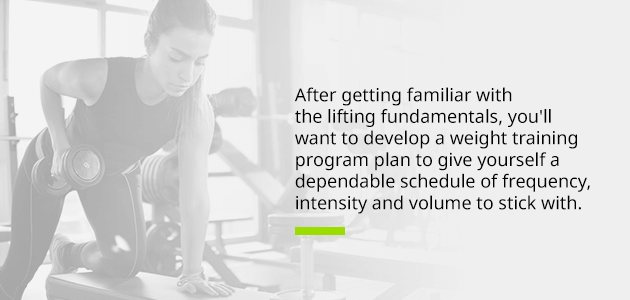 After getting familiar with the lifting fundamentals, you'll want to develop a weight training program plan to give yourself a dependable schedule of frequency, intensity and volume to stick with. A good weight training program will incorporate a custom combination of the following weight lifting variables to help you accomplish your fitness goals:
After getting familiar with the lifting fundamentals, you'll want to develop a weight training program plan to give yourself a dependable schedule of frequency, intensity and volume to stick with. A good weight training program will incorporate a custom combination of the following weight lifting variables to help you accomplish your fitness goals:
- Type of lift
- Amount of weight or resistance
- Number of reps
- Number of sets
- Rest between sets
- Rest between training days
Check out these popular techniques used for weight training and bodybuilding to help you craft your own training program:
- Full body training: This technique works all the major muscle groups within one gym session by using a series of lifts that hits each major muscle group at some level.
- Supersets: This approach focuses on stimulating muscle growth while providing adequate rest by exercising two opposing muscle groups in quick succession and alternately resting.
- Compound sets: Instead of alternating muscle groups, a compound set alternates exercises or equipment while working the same muscle group to push and grow those muscles.
- Periodization: Periodization involves cycling through phases of training over a set amount of time to see results by a scheduled date. For example, you can divide a year-long program into separate training modules with their own goals.
- Split system: Bodybuilders often use the split system. The idea is to rotate through different major muscle groups each session by designating certain days, such as leg day or upper-body day.
- Pyramid: A pyramid program is based on a series of sets that progressively moves from more reps at a lighter weight to fewer reps at a heavier weight.
- Drop sets: Almost like a reverse pyramid, drop sets begin with heavier weight and you lift until failure, then you switch to a slightly lighter weight and continue to lift until failure again, and so on. This is a form of high-intensity training with little rest between sets.
- Eccentric training: This type of training emphasizes the return action of a lifting exercise, such as lowering yourself down from a pull-up, as this is the action that damages the most muscle so more can be built.
- Superslow: The superslow method uses eccentric training but also slows down the initial lifting motion to make each phase of a lift exaggerated.
- Sport-specific:You can follow a training plan created to enhance performance in a specific sport by working the muscles most used during that sport.
Although increasing the strength, size, and endurance of muscles are centered around bumping up to heavier weights, it's important to start lifting with a manageable weight. Begin with lighter weights to ensure proper form and safety, then gradually increase the volume as you improve. Every exerciser is different, so make sure your training program is compatible with your own goals, weight lifting experience, commitment, and ability level.
How to Build Muscle and Prevent Injury
The most effective way to build muscle and stay healthy is to use proper form when strength training. Proper exercise form can protect you from straining a muscle or overly stressing a joint and getting injured. In fact, fewer reps with proper form can be more effective for developing muscle than more reps with bad form.
Keep these tips for injury prevention and proper fitness practices in mind when lifting:
- Get warm: Because cold muscles are less pliable and more prone to injury, always begin your workout with a few minutes of aerobic activity to warm up your muscles.
- Stay focused: Concentrating on the muscle groups you're working will help you maintain good form throughout your workout. Make sure you master form before attempting to speed up an exercise.
- Work your muscles: Make sure your muscles are the force that's lifting the weights, not momentum. More muscle fibers are activated when you lift and lower weight with control throughout the full range of motion. Remember that swinging is never your friend — if you can't lift a weight without swinging it, then you should use a lighter weight.
- Maintain good posture: Because hunching your shoulders and holding tension in your neck puts unnecessary strain on your muscles, stand tall and engage your core whenever you lift weights to ensure good form.
- Watch for small details: Small adjustments like tucking your elbows close to your sides or keeping a slight bend in your knees can make a big difference, so make sure you take note of every detail in your form.
- Breathe: Performing a difficult lift can make people naturally want to hold in their breath, but breathing will help you lift more effectively. Exhale during the hardest part of the lift to fuel the movement, and inhale on the release.
- Try bodyweight exercises: Bodyweight moves can be equally as challenging and effective as traditional weightlifting. If you struggle with maintaining proper weightlifting form, consider taking a step back and focusing on bodyweight exercises like planks and push-ups.
- Listen to your body: Although muscle fatigue or tiredness can be worked through, you should immediately stop lifting whenever you feel intense or sharp pain. Continuing to lift while experiencing pain can lead to a more serious injury and set you back further.
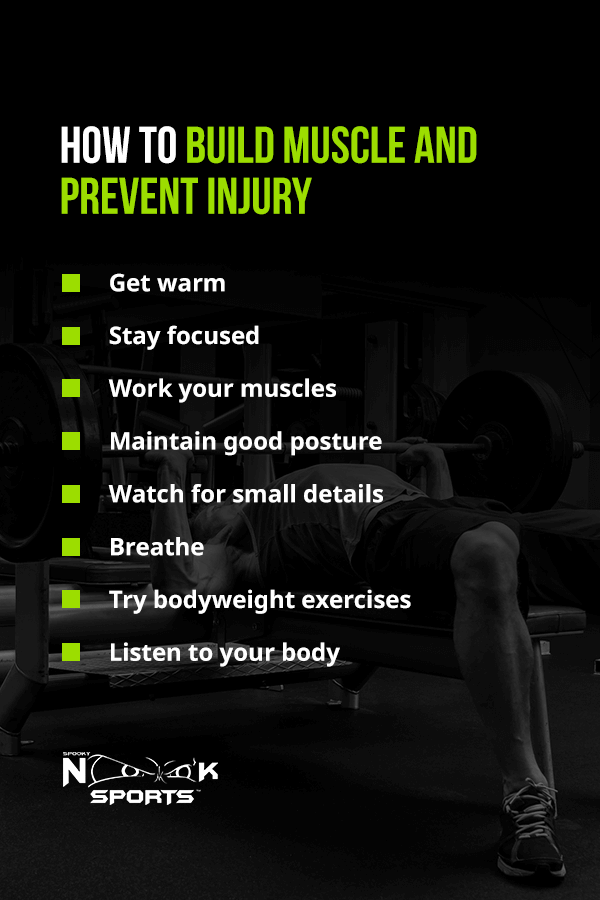 Now that you know the main tips for proper exercise form, here are seven common workout mistakes to avoid:
Now that you know the main tips for proper exercise form, here are seven common workout mistakes to avoid:
1. Arching Your Back
Bending backward as you push overhead puts a dangerous amount of stress on the joints in the lumbar spine, which can lead to serious injury. To prevent this issue, squeeze your core and glutes as tight as you can to stabilize your lower back and help you safely lift more weight overhead.
2. Not Going Low Enough in Squats
Whenever you squat, your quads should be parallel to the ground or lower. Otherwise, you're limiting your range of motion and the strength you could be building in your leg muscles. Because the weight of the barbell doesn't shift onto the hips until the legs reach a parallel position, not squatting low enough could also damage your knees.
Instead of staying too high in your squat, drop deep enough to get your thighs parallel to the ground as you brace your core for stability.
3. Trying to Row Without Shoulder Blades
If your elbow travels too far behind the ribcage as you row with a barbell or dumbbell, you're missing out on strengthening your back and bolstering your shoulder health. To keep proper form, let your shoulder blade glide inward over the ribcage when you row — you should feel like you could pinch a penny between your shoulder blades at the top of the row.
4. Bad Pull-Up Posture
Your shoulders should never round forward as you pull up because doing so fails to shape the shoulder muscles and aggravates poor posture. Concentrate on pulling your chest up and your shoulder blades down and in when you pull up. These motions will stimulate the muscles that protect your shoulders and build good posture.
5. Relying on Your Arms for Kettlebell Swings
Kettlebell swings are intended to target the muscles around your hips, knees, and ankles. By isolating the hips, kettlebell swings engage your core muscles as well to help keep your shoulders safe. Try not to use your arms to pull the kettlebell, which should never rise above your head, to avoid straining your shoulders.
6. Using the Legs During Bench Press
Never flail your legs if you get stuck during a bench press rep because it wastes power. Before you begin to bench press, push your feet toward the ground while keeping your rear on the bench. This practice will tighten your lower-body while increasing your stability and strength.
7. Pointing Elbows Out to Bench
Trying to bench press when your elbows are pointed directly out to the sides places too much stress on the shoulder joints, which usually results in injury. Keep your elbows close to the ribcage as you drive the barbell up to put the burden on your chest and triceps while alleviating the amount of pressure on your shoulders.
How to Check Form When You're Working Out Alone
Even if you know proper weightlifting form and practices to prevent injury, it can be difficult to keep close tabs on your form while working out alone. It's always best to have a spotter — whether it be a friend, personal trainer, or coach — to help you maintain correct form for lifting weights, but on days when nobody is available to accompany you to the gym, stick to these tips for maintaining proper form while working on your own: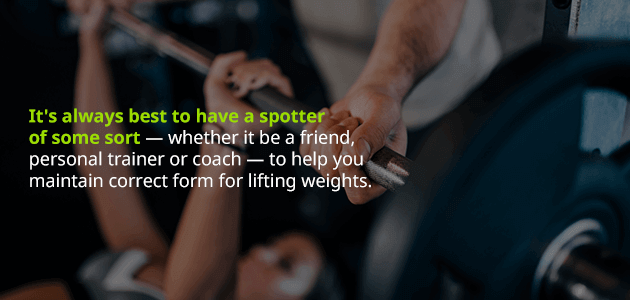
Start Small
Especially if you're new to weight lifting, begin with basic movements using little to no weight. Pay close attention to each muscle that the move engages and double-check your form at each phase of the lift. After you've gotten comfortable with the motion and perfected your form, you can add weight and try more advanced moves.
Use a Mirror
Gyms are filled with full-length mirrors for a reason — watching your reflection as you weightlift is one of the easiest ways to keep your form in check. Because maintaining proper form is all about muscle memory and repetition, practicing your form in front of a mirror without holding any weights can be helpful as well. The more you practice and teach your body a certain range of motion, the more natural the movement will start to feel.
Record Yourself
Although it might feel awkward at first, video recording yourself during a workout can greatly benefit your form and posture. After seeing firsthand how your body moves while lifting, you'll be able to recognize and correct your form and any other areas of weakness. If you have a trainer or fitness-savvy friend, you can watch the video with them and ask for advice on how you can improve your weight lifting performance.
Conserve Your Energy
While there is a time to push yourself at the gym, be careful not to try extremely advanced or challenging moves before you're ready. Make sure you master the basics before moving on. Similarly, get in the habit of gradually easing into a workout instead of going all out as soon as you start. This will give you time to adjust your form and detect any pain or potential injury.
How Proper Form Prevents Injury and Produces Results
Once you've gotten into the groove of routinely working out, the last thing you want is for an injury to slow you down or throw off your training plan. The most effective way to avoid injury is to take care of your body by practicing good form whenever you're in the gym. Proper form helps to prevent the wrong joints or muscles from bearing the brunt of the weight, which tends to make them more vulnerable to injury.
Considering the importance of proper workout form, working with a personal trainer is often highly beneficial. By overseeing your every move, a personal trainer can ensure you remain injury-free as you push your limits.
Booking a personal trainer for exercise sessions is a great way to get reliable workout advice and form critique to avoid injury and stay on track to achieve your goals. Along with form and fitness assistance, a personal trainer can help keep you motivated and accountable. Working alongside your personal trainer allows you to create and stick to a personalized workout plan that can help you accomplish all your fitness goals while staying safe in the gym.
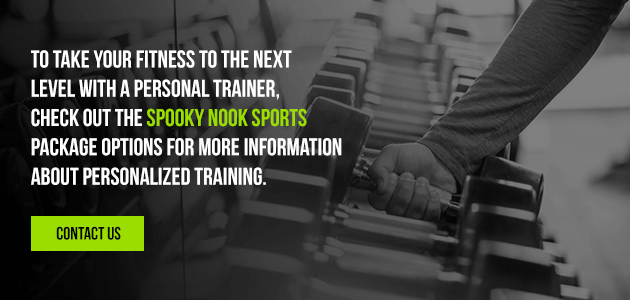 When you're choosing a personal trainer, make sure to look for someone who is certified and has good experience in the field. At Spooky Nook Sports, our friendly personal trainers are both highly skilled and qualified to help you get the most out of your workouts. With a personal trainer and custom training program, you'll be able to optimize your time at the gym and get the results you want.
When you're choosing a personal trainer, make sure to look for someone who is certified and has good experience in the field. At Spooky Nook Sports, our friendly personal trainers are both highly skilled and qualified to help you get the most out of your workouts. With a personal trainer and custom training program, you'll be able to optimize your time at the gym and get the results you want.
To take your fitness to the next level with a personal trainer, check out the Spooky Nook Sports package options or contact us for more information about personalized training.










